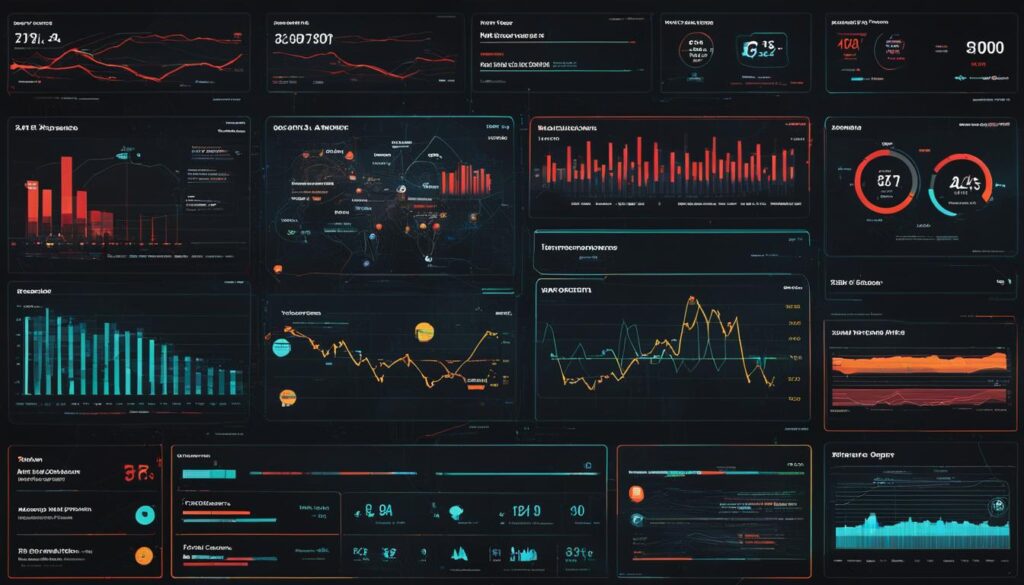As the digital landscape continues to evolve, so does the necessity for robust cybersecurity solutions. At the forefront of digital landscape protection is the sophisticated technology known as a SIEM tool—a pivotal component in modern security strategies. The SIEM definition, short for Security Information and Event Management, hinges on its capacity to furnish organizations with the means to preemptively detect, address, and avert security threats that could disrupt operations.
Encompassing more than just rudimentary log accumulation, a SIEM tool overview reflects its versatility in analyzing historical security data in tandem with real-time monitoring. This dual approach equips security personnel with the agility to spot peculiarities in user behavior and to automate threat recognition alongside incident response measures. Leveraging the power of artificial intelligence, SIEM technologies are instrumental in elevating traditional log management to provide intricate security analytics. The integration of user and entity behavior analytics (UEBA) and machine learning has turned these platforms into critical assets within Security Operation Centers (SOCs) worldwide, bolstering defense against increasingly sophisticated threats.
Key Takeaways
- SIEM serves as a cornerstone technology for cybersecurity, capable of advanced threat prevention and management.
- The tool exemplifies a merger of AI and traditional security measures to guard against modern cyber risks.
- A SIEM tool’s real-time monitoring and historical data analysis contribute to its efficacy in anomaly detection.
- With integrated UEBA and machine learning, SIEM systems are vital in detecting nuanced threats across SOCs.
- Efficient SIEM deployment empowers organizations to enhance their digital landscape protection capabilities.
Understanding SIEM and Its Evolution
The realm of cybersecurity is continuously evolving and adapting to counteract an ever-expanding array of digital threats. Standing at the forefront of this dynamic field is the Security Information and Event Management (SIEM) technology. This powerful tool has advanced from its nascent iterations as two distinct entities – Security Information Management (SIM) and Security Event Management (SEM) – into an integrated solution critical for today’s cybersecurity requirements.
The Genesis of SIEM: SIM and SEM
At its core, SIEM for cybersecurity is the brainchild of the synergy between SIM and SEM. SIM’s role as a repository for logging security-related data merged with SEM’s directive to analyze event data in real-time, providing a cohesive platform designed for both immediate security monitoring and long-term archival needs. This integration was a turning point signifying a new era where compliance and auditing were no longer afterthoughts but integral components of the cybersecurity toolbox.
From Basic Log Management to Advanced Threat Detection
As the digital threat landscape expanded, so did the necessity for more comprehensive tools capable of both detecting and responding to intricate risks. The transition from basic log management to advanced threat detection is one of the critical milestones in SIEM implementation. Modern SIEM features now employ AI-driven SIEM systems capable of processing high volumes of data, sifting through them with advanced analytics and machine learning to illuminate potential threats in real time.
Currently, SIEM use cases have outgrown simple data collection and compliance reporting to encompass intricate scenarios invocative of James Bond films – albeit in the digital realm. The tool’s repertoire now includes using User and Entity Behavior Analytics (UEBA) to spot anomalies indicative of insider threats, leveraging AI for SIEM integration with other security tools, and providing cybersecurity professionals with actionable insights to preemptively strike against potential breaches.
In conclusion, the transformative journey of SIEM from a compliance assistant to the guardian of the modern cybersecurity landscape is nothing short of remarkable, ensuring that organizations can stay vigilant against an ever-evolving parade of cyber threats.
Key Functions of a SIEM Tool
The cornerstone of cybersecurity within an organization often rests upon the robust capabilities of their SIEM tool functions. These tools are not just about data collection and storage; they activate a suite of features that transform the security management landscape.
Data aggregation stands out as one of the most critical utilities of a SIEM tool, unifying information from various points of the IT ecosystem. This may include but is not limited to, endpoints, network devices, and applications—each being sources that offer insight into the ever-evolving threats and vulnerabilities faced by institutions today.
- Data Aggregation: SIEM systems collect security data from across the network, contributing to comprehensive surveillance and threat detection efforts.
- Event Correlation: Through the use of sophisticated algorithms, these tools correlate disparate activities to identify subtle signs of cyber intrusions, thereby reducing the time between threat detection and response.
- Compliance Management: In an environment replete with regulatory demands, SIEM tools ease the strain of adherence to standards such as PCI-DSS, GDPR, HIPAA, and SOX by automating and systematizing the generation and dispatch of compliance reports.
- Incident Response: When threats are detected, the SIEM’s incident response capabilities facilitate swift action, often with protocols that can automate certain remediation tasks upon the confirmation of a security event.
Each function of the SIEM tool intertwines with the others, creating a labyrinth of checks and balances that strive to keep an organization’s data integrity intact. Real-time event correlation, as a function, heightens the capacity for timely intervention. However, it is the compliance management feature that often garners the attention of regulatory bodies, showing that the organization is not only vigilant but also responsible for the data within its purview.
Lastly, the inevitable occurrence of an incident is handled with rigor through tailored incident response protocols, potentially mitigating harm and paving the way for recovery. It’s through these compounding SIEM tool functions that enterprises can assert a proactive stance against cybersecurity risks, both seen and unforeseen.
What is a SIEM Tool: Defining Security Information and Event Management
When delving into the realm of cybersecurity, one frequently asked question is, what is a SIEM tool? Standing for Security Information and Event Management, a SIEM platform is more than a technological innovation; it’s the bedrock of adept security incident management. In the digital age where data breaches are commonplace, understanding security analytics and threat detection is paramount.
At its core, a SIEM aggregates logs and data from various sources within an organization’s network, offering a keen eye for anomalies and potential threats. But it goes beyond the assimilation of data; it interprets, sorts, and correlates the information, revealing irregular patterns that could indicate a security incident.
Think of a SIEM as a vigilant sentry, ceaselessly overseeing activities and ensuring that the integrity of a system remains intact. By harnessing the power of security analytics, a SIEM tool provides an integrated overview of an organization’s security posture, enabling rapid identification and remediation of breaches or attempted attacks.
The true power of a SIEM tool lies in its dual capability of historical data analysis for compliance and real-time monitoring for incident prevention.
Essentially, SIEM is mission-critical technology in the contemporary security landscape. It aids in preempting security incidents, thus allowing for a proactive rather than reactive approach to cyber threats. By flagging discrepancies from established patterns, it streamlines the process of threat detection and response, making it an indispensable ally in the fight against cybercrime.
- Real-time monitoring for active threat detection
- Historical data analytics for pattern recognition and compliance reviews
- Security alerts that facilitate swift incident response tactics
In summary, a SIEM tool underpins an organization’s ability to protect sensitive data from ever-evolving threats. Its functions, although complex, pivot around the straightforward goal of sustained organizational cybersecurity.
How Does SIEM Work?
At the heart of modern cybersecurity strategies, SIEM tool functions act as the central nervous system for IT infrastructure monitoring. The technology’s prowess stands on its ability to deliver comprehensive log management, real-time monitoring, and incident monitoring, which are critical for maintaining an organization’s security posture.

Data Aggregation Across IT Infrastructure
The robust SIEM analytics engine begins by gathering voluminous event logs from every corner of an organization’s IT environment. This process is not limited to hardware within the company walls but extends to cloud-based services and remote endpoints, ensuring a full-spectrum view of potential vulnerabilities.
Real-Time Event Correlation and Analytics
Following the sweeping aggregation phase, SIEM systems shine in their event correlation abilities. SIEMs apply sophisticated analytics to decipher intricate patterns buried in the gathered data. These capabilities are key to discerning legitimate threats from benign anomalies, enabling teams to respond accurately and swiftly.
Incident Monitoring and Automated Security Alerts
The final piece of the SIEM puzzle is its incident monitoring and generation of automated security alerts. These alerts are dispatched based on customized parameters set within the SIEM dashboard, forming the first line of defense against security breaches by prompting immediate action from response teams.
| Feature | Benefit | Function |
|---|---|---|
| Data Aggregation | Complete overview of IT health | Collects logs from various sources |
| Real-Time Monitoring | Timely threat detection | Live tracking of system activities |
| Event Correlation | Contextual threat identification | Analyzes and links related events |
| Automated Security Alerts | Proactive incident response | Generates notifications for anomalies |
| SIEM Dashboard | Centralized control | Provides actionable insights |
Advancements in SIEM: AI and Machine Learning
The realm of cybersecurity is witnessing a remarkable transformation with the advent of AI-driven SIEM. Integrating machine learning in cybersecurity, contemporary SIEM systems have transcended the boundaries of traditional security measures, ushering in an era of enhanced threat detection and swift response mechanisms. These advancements are not just incremental; they represent a quantum leap in our ability to safeguard our digital infrastructure.
In the vein of innovation, SIEM tools now boast sophisticated algorithms capable of analyzing swathes of data to learn and predict network behavior. This leading-edge approach allows for a nuanced understanding of potential threats, significantly reducing the incidence of false positives and quickening the pace of incident resolution.
- Machine learning algorithms fine-tune security monitoring, adapting to new threats with unmatched precision.
- Pattern recognition and anomaly detection are now more acute with AI-enhanced predictive analytics.
- SOAR systems integrations enable automated workflows, fostering a proactive security posture.
Indeed, the combination of AI-driven SIEM tools and SOAR systems is a testament to the dynamic nature of cybersecurity. By streamlining incident response through orchestrated automation, organizations can now address security alerts at machine speed, minimizing the window of exposure to potential threats.
Let us delve into the core characteristics that set these next-generation SIEM systems apart:
AI-driven automation in SIEM is not just about speed; it’s also about intelligent prioritization and resource allocation – ensuring that security teams focus on the most significant threats first.
Security orchestration and AI-driven approaches underscore a profound shift in cybersecurity strategy – one that is more adaptive, more intelligent, and incredibly more effective than ever before.
As we march towards a future where cyber threats become increasingly sophisticated, the integration of AI and machine learning into SIEM technologies is not merely an option; it’s an imperative. Organizations that embrace these AI-driven SIEM advancements are poised to enjoy robust protection, ensuring the security of their digital assets in an unpredictable cyber landscape.
What a SIEM Dashboard Looks Like
At the heart of security oversight, the SIEM dashboard stands as a command center, presenting a panoramic view that is critical for maintaining the integrity of IT environments. With its sophisticated integration of various system inputs, the SIEM dashboard synthesizes information to present security professionals with clear and actionable insights.
Centralized Monitoring for In-Depth Security Oversight
A SIEM dashboard is integral to security operations, providing a centralized framework for monitoring widespread network activity. This centralization brings together disparate data points, offering a cohesive outlook that promotes informed decision-making for security oversight. In doing so, it propels organizations towards achieving robust defense mechanisms against emerging threats.
Data Visualization for Immediate Threat Recognition
Utilization of data visualization in SIEM dashboards underscores their value in spotting patterns and anomalies that might indicate a security event. These powerful visual aids are crafted to facilitate immediate threat recognition, enabling quick and precise security analysis which is vital in today’s fast-paced cybersecurity landscape.
The design of a SIEM dashboard typically includes various elements that help to simplify the complex data generated within an organization’s networks. Below is a depiction of what users may typically find on a SIEM dashboard:
| Feature | Description | Purpose |
|---|---|---|
| Real-time Alerts | Notifications about potential security incidents as they occur. | Allows for rapid response and mitigation of potential threats. |
| Trend Analysis | Graphical representation of event trends over time. | Helps to identify unusual patterns and prolonged security issues. |
| Threat Maps | Global view of origin points for potential security threats. | Provides geographical context to attacks, aiding in threat intelligence. |
| System Health | Current status and performance analytics of security tools and systems. | Ensures that all security apparatuses are functional and efficient. |
| Compliance Widgets | Summary of compliance stance against regulatory requirements. | Keeps the organization informed on compliance status and potential issues. |
demonstrates some of the vital components one might expect to see on a highly sophisticated SIEM dashboard.
SIEM in Compliance Management and Reporting
As the demands for compliance management intensify across industries, Security Information and Event Management (SIEM) reporting has become a linchpin for meeting those requirements. The ability of SIEM solutions to streamline expansive data into coherent, actionable reports makes it indispensable for regulatory compliance.
SIEM tools are proficient in automating the once cumbersome process of data collection and analysis, providing real-time visibility into security events that bear on regulatory standards. These standards, such as PCI-DSS, GDPR, and HIPAA, come with a slate of reporting mandates that SIEM systems address with finesse, ensuring that organizations maintain secure business operations and comply with legal frameworks.
- Data Aggregation: SIEM collects information from across the IT ecosystem in real-time.
- Event Correlation: SIEM correlates events to detect potential compliance issues.
- Automated Reporting: SIEM generates reports that simplify the audit process, providing evidence of compliance.
- Alerts Management: SIEM notifies stakeholders of compliance deviations instantly, promoting swift remediation.
Below is a representation of how these functions blend into the process of managing compliance through SIEM:
| Compliance Requirement | SIEM Function | Benefit to Organization |
|---|---|---|
| Reporting for PCI-DSS | Automated Cardholder Data Environment Monitoring | Simplifies adherence to payment card security standards |
| General Data Protection Regulation (GDPR) Accountability | Real-time Personal Data Breach Detection | Enhances the protection of individual data rights |
| Health Insurance Portability and Accountability Act (HIPAA) Compliance | Secure Patient Data Management and Reporting | Secures sensitive healthcare information, reducing liability |
When it comes to SIEM reporting, businesses benefit from refined controls and an integrated compliance framework that affords them a competitive edge in security management. This integration is not only beneficial for the sake of regulation but also fosters a culture of continuous compliance, elevating the organizational stature in terms of reliability and trustworthiness.
In essence, the advancements in SIEM have redefined what it means to achieve compliance in today’s high-stakes cyber environments. By capitalizing on the technological prowess of SIEM reporting, organizations effectively navigate the treacherous waters of regulatory compliance, forestalling penalties, and fortifying their data against breaches.
Benefits of SIEM Tool in Cybersecurity
In today’s rapidly evolving cyber threat landscape, Security Information and Event Management (SIEM) tools stand at the forefront of cybersecurity defenses, offering numerous benefits that fortify an organization’s protective measures. The advent of real-time threat recognition capabilities, coupled with the power of AI-driven automation, represent a significant upsurge in how security threats are managed and neutralized.
Efficient Real-Time Threat Recognition
One of the most significant advantages of utilizing a SIEM system is its capacity for real-time threat recognition. This ability not only enhances the security posture of organizations but also ensures a proactive approach to potential security incidents. SIEM tools effectively analyze and correlate events across an organization’s network, swiftly identifying anomalies that could indicate a security breach in progress. This immediate identification facilitates timely interventions before threats can propagate.

AI-Driven Automation for Security Operations
The integration of AI-driven automation within SIEM tools has transformed security operations by introducing sophisticated mechanisms for security orchestration. This blend of technology not only streamlines threat identification but also refines the response process through automation. By reducing the need for manual intervention, SIEM benefits security teams by allowing them to focus on strategic analysis and oversight instead of getting mired in repetitive tasks.
Moreover, SIEM’s role in centralized compliance auditing is invaluable, simplifying the complex process of maintaining adherence to various regulatory frameworks. Features such as preconfigured compliance reports and real-time monitoring for policy violations significantly aid in ensuring that organizations meet stringent regulatory standards without exhaustive labor.
Invariably, SIEM tools have become instrumental in empowering organizations with advanced threat identification and response. As cyber threats grow more sophisticated, so do the solutions designed to combat them. The blend of AI-powered analysis with comprehensive security data aggregates provides a formidable defense against the ever-increasing array of cyber risks threatening today’s digital infrastructure.
Exploring SIEM Use Cases
In the realm of cybersecurity, Security Information and Event Management (SIEM) plays a pivotal role in fortifying an organization’s defense mechanisms. Notably, the SIEM’s use cases extend into critical areas such as insider threat detection, ransomware protection, and DDoS attack prevention. Let us explore how SIEM tools deliver potent safeguarding capabilities against such intricate security challenges.
Combating Insider Threats
Insider threats emerge from within the organization, often inadvertently due to negligent or compromised employees. SIEM systems excel here by integrating network access monitoring with threat intelligence feeds. This comprehensive surveillance enables the identification of abnormal behavior patterns, including unusual data access or transfers, which may indicate a security breach or malicious intent.
Protecting Against Ransomware and DDoS Attacks
Cyberattacks have grown more sophisticated, with ransomware causing significant financial and data losses while DDoS attacks disrupt crucial online services. SIEM tools, equipped with advanced analytics, provide ransomware protection by detecting the early signs of a breach and triggering alerts for immediate action. To address DDoS attack prevention, they analyze incoming traffic patterns, filtering out malicious activities to maintain the integrity of network services.
| Security Challenge | SIEM Benefit | Resulting Action |
|---|---|---|
| Insider Threats | Real-time Anomaly Detection | Quick Response to Unusual Activity |
| Ransomware | Automated Alerts for Threat Indicators | Preventive Measures Before Data Encryption |
| DDoS Attacks | Traffic Analysis and Filtering | Continuity of Online Services |
By employing SIEM systems, organizations are armed with an effective toolkit to counteract the array of security vulnerabilities threatening the digital infrastructure. Furthermore, the proactive and intelligent capabilities of SIEM indeed render it a cornerstone technology in modern cybersecurity arsenals.
Challenges and Limitations in SIEM Implementation
Integrating a Security Information and Event Management (SIEM) system within an organization’s digital environment is no small feat. SIEM challenges often stem from its complexity and the need for a substantial time commitment to ensure its full integration with existing security measures. Moreover, aside from the hefty initial set-up costs, the ongoing SIEM limitations in terms of management expenses must be accounted for. Together, these factors can add considerable strain on an organization’s resources.

One significant hurdle often encountered is the technical expertise required to configure and maintain SIEM systems. They demand constant attention and fine-tuning to keep up with the evolving threat landscape, a task that requires a high level of skill and experience. Even with the proper know-how, the likelihood of overlooking critical security alerts due to misconfiguration or overly complex rule sets is worryingly high. This complexity can lead to inadequate threat detection and potentially disastrous oversights.
Furthermore, scalability issues add another layer to the SIEM challenges. As organizations grow and the volume and complexity of data increase, some SIEM solutions struggle to adapt. This can lead to performance bottlenecks, misplaced data, or even system failures – all of which compromise security and compliance.
- Complexity in Configuration and Maintenance
- High Operational Costs
- Demand for Specialized Expertise
- Overlooking of Crucial Security Events
- Performance Issues with Scaling Data Volume
The intricacies of SIEM implementation cannot be understated, and it is crucial for organizations to recognize and address these potential drawbacks in order to derive the fullest benefit from their SIEM solution. A keen awareness of these limitations allows for a more strategic and adept approach to maximizing SIEM effectiveness within the cybersecurity infrastructure.
SIEM Tools and Software: Leading the Market
As enterprises quest for complete security over their digital estates, the importance of leading SIEM solutions in their cybersecurity strategy has skyrocketed. Among the top contenders in this arena are Splunk, IBM QRadar, LogRhythm, and Exabeam. Each of these platforms empowers organizations with unparalleled security monitoring, advanced threat detection, and strategic incident response capabilities.
| Feature | Splunk | IBM QRadar | LogRhythm | Exabeam |
|---|---|---|---|---|
| Data Aggregation | Highly scalable | Wide data source integration | Extensive log management | User and entity behavior analytics |
| Correlation Analysis | Real-time processing | Advanced AI algorithms | Multi-dimensional analysis | Smart timelines for anomaly detection |
| Dashboard Visualizations | Intuitive graphical interface | Customizable real-time dashboards | Comprehensive reporting tools | Behavioral analysis graphs |
| Incident Management | Automated detection and response | Integrated offense management | AI-based threat lifecycle management | Automated incident timeline creation |
Each SIEM solution brings to the table distinctive features to cater to diverse cybersecurity needs. Splunk shines with its escalating scalability to handle massive data sets, critical for large enterprises. IBM QRadar is renowned for its AI-driven analytics, offering a deep dive into security data intricacies. Agile and proactive, LogRhythm‘s multi-dimensional analytics empower smaller teams to stay ahead of threats efficiently. Conversely, Exabeam excels in its user and entity behavior analytics, bolstering defenses against insider threats and compromised accounts.
Choosing the right SIEM software is not just about the features it offers; it’s also about aligning capabilities with the unique demands of an organization’s IT environment. The right SIEM solution becomes the linchpin of a robust cybersecurity program, a vigilant guardian against the ever-evolving landscape of digital threats.
Choosing the Right SIEM Solution for Your Organization
When it comes to selecting SIEM products, it’s not just about finding a tool, it’s about discovering the right partner for your organizational security. A myriad of factors come into play, and piecing them together requires a diligent analysis of what your organization stands to gain from the chosen solution. Incident management, compliance reporting, and the ability to scale—these are the linchpins of a successful SIEM deployment.

The first step is to weigh your organization’s current and future security needs against the offerings of various SIEM products. Consider the volume of data your organization will need to process and whether the product can handle this scale both now and as you grow. Equally important is the solution’s capacity for incident management, which is the heartbeat of any SIEM system.
- Examine compliance reporting features against regulatory requirements your organization needs to meet.
- Ensure that the solution can integrate smoothly with existing security controls and infrastructure.
- Gauge the sophistication of AI and machine learning capabilities for proactive threat detection.
- Seek out options that provide robust support for threat intelligence feeds.
- Assess the scalability of the system for future expansion or reduction.
- Inspect the forensic analysis functionalities for deeper dive investigations post-incident.
- Review the extendibility of the product to provide extensive and customizable compliance reporting.
In the quest for enhanced cyber resilience, a SIEM solution is more than an addition to your tech stack—it’s your frontline defense in a complex security landscape. Therefore, the decision-making process should be embraced with a strategic vision tailored to the pillars of your organization’s security posture. By keeping these considerations in forefront, businesses can make an educated selection that aligns with their security framework and strategic imperatives.
Remember, the effectiveness of a SIEM product is ultimately measured by the seamless manner in which it melds into your security ecosystem, fortifying the very foundations of your digital environment.
Conclusion
In the ever-evolving digital age, a robust cybersecurity strategy becomes essential to ensure an organization’s resilience against malicious activities. The deployment of a SIEM tool exemplifies a strategic commitment to security threat mitigation, empowering teams with the necessary capabilities to detect, analyze, and respond to cybersecurity incidents effectively. As the complexity of cyber threats increases, the need for adaptive and efficient cybersecurity solutions becomes more apparent.
The robustness of SIEM tool deployment lies in its capacity to fuse historical and real-time data analytics, thus affording businesses a comprehensive view into their security posture. The integration of artificial intelligence within these tools further enhances this functionality, automating the detection of anomalous behavior and streamlining the incident response process. This advanced orchestration of security processes is not just a luxury but a necessity in safeguarding critical digital assets against a myriad of threats.
In conclusion, the proper implementation of a SIEM tool within an organization’s cybersecurity strategy significantly bolsters its ability to preemptively address security concerns. Aligning with regulatory compliance and providing an enhanced layer of protection, SIEM solutions are indispensable allies in the ongoing battle against cyber threats. Their deployment serves as a testament to an organization’s dedication to maintaining the integrity of its digital landscape, ultimately supporting its overarching mission of fortifying its cyber-defenses.
FAQ
What is a SIEM Tool?
A SIEM tool, which stands for Security Information and Event Management, is a cybersecurity solution designed to provide organizations with a comprehensive overview of their digital landscape’s security. By collecting and analyzing data from various sources within the IT infrastructure, SIEM tools help identify and respond to security threats in real time, ensuring digital landscape protection.
How has SIEM evolved over the years?
SIEM has evolved from the combination of Security Information Management (SIM) and Security Event Management (SEM), offering basic log management capabilities, to sophisticated platforms that leverage AI and machine learning for advanced threat detection. This evolution reflects the tool’s growing importance in the cybersecurity landscape.
What are the key functions of a SIEM Tool?
Key functions of a SIEM tool include data aggregation from multiple sources within the IT infrastructure, real-time event correlation for detecting threats, compliance management with automated reporting for regulatory standards, and efficient incident response to minimize the impact of security breaches.
How does SIEM work?
SIEM works by collecting and aggregating log data across an organization’s entire IT infrastructure, including on-premises and cloud environments. It then uses real-time event correlation and analytics to detect anomalies, generate alerts, and provide visual data representations through a dashboard for incident monitoring and managing automated security alerts.
What advancements in SIEM are powered by AI and Machine Learning?
Advancements in SIEM powered by AI and machine learning include the development of sophisticated algorithms to detect complex threats, improve the accuracy of threat identification, and integrate with SOAR systems for automated response to security incidents, reducing the time required to manage such events.
What does a SIEM dashboard look like?
A SIEM dashboard provides centralized monitoring with an intuitive interface showing real-time data visualizations, alerts, and system notifications. It allows security personnel to have in-depth security oversight and offers tools for immediate threat recognition, making it easier to analyze and respond to potential security issues.
How does SIEM support compliance management and reporting?
SIEM supports compliance management and reporting by automating data collection and analysis to meet regulatory standards such as PCI-DSS, GDPR, and HIPAA. It provides real-time reports and dashboards, helping organizations maintain regulatory compliance with less effort and increased accuracy.
What are the benefits of a SIEM tool in cybersecurity?
Benefits of a SIEM tool in cybersecurity include efficient real-time threat recognition, centralized compliance auditing, advanced threat identification, and AI-driven automation that enhances security operations. These capabilities help organizations respond swiftly and effectively to potential security threats.
Can SIEM tools help in combating insider threats?
Yes, SIEM tools are very effective in combating insider threats. They monitor network access and user behavior in real-time, allowing for the detection of suspicious activities or policy violations from individuals within the company, thus mitigating security risks posed by insiders.
How do SIEM tools protect against ransomware and DDoS attacks?
SIEM tools protect against ransomware and DDoS attacks by leveraging threat intelligence feeds and AI technology to detect and alert security teams about these cyberattacks. SIEM can help preemptively block these attacks and facilitate a swift response to mitigate damage.
What are the challenges and limitations of SIEM implementation?
Challenges and limitations of SIEM implementation include the complexity of integration into existing security controls, substantial costs of setup and maintenance, and the potential for overlooking security events if not properly configured or managed. Expertise is required for effective deployment and continuous management of a SIEM system.
What are some leading SIEM solutions in the market?
Leading SIEM solutions in the market consist of Splunk, IBM QRadar, LogRhythm, and Exabeam. These products offer a range of features for security monitoring, advanced threat detection, forensic analysis, and incident response, catering to the diverse needs of organizations of different sizes.
How should an organization choose the right SIEM solution?
To choose the right SIEM solution, organizations should consider their budget, specific security needs, and strategic goals. Factors such as compliance reporting capabilities, integration with existing security controls, incorporation of artificial intelligence, threat intelligence support, scalability, and forensic analysis features should be evaluated when selecting a SIEM product.


